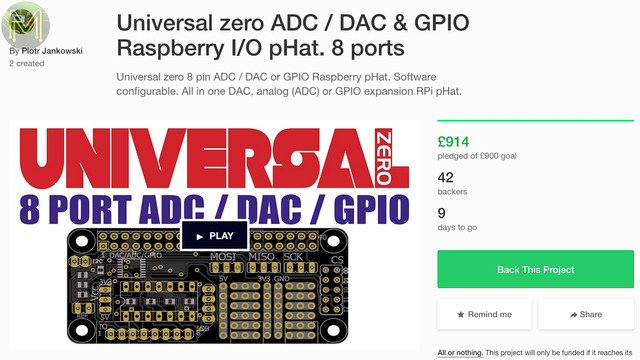Weekly Roundup #24 - New Maker Products // News
This week’s roundup looks at Robots, FPGAs, LoRa, 3D printing, even more robots and LoRa and I think there’s an SBC in there somewhere.
Honorable mentions
It was a bit of a slow start to the year, but we’re starting to see some good stuff for the electronics Maker. Well, except for things like …
Sego
… the Sego which is another robot scam product that’s supposed to look after your pet.Caia
Or the Caia sunshine robot… Or maybe it’s not a scam… Anyway… moving on.Crowd Funding
KickStarter
Kickstarter has finally revved up for the year …
Dexter
… to something a little more realistic. The Dexter is a 5 axis robotic arm that can be trained to do whatever you want with 50 micron repeat-ability. That sort of accuracy does come at a cost, at around $2, but that’s pretty good for what it does.It uses the Zynq FPGA on a board called the MicroZed, which runs Ubuntu Linux on the dual core ARM9 CPU. Nice board, I had to look this one up as it was the name of my late Uncle’s electronics importing company.
MicroZed FPGA
The board runs the Zynq-7000 SoC, with 1G DDR3 RAM, 128M SPI flash, gigabit Ethernet, USB, JTAG, and 100 GPIOs.Pretty good for the price.
Robot Core
And yet more stuff on robots with the Robot Core, which is designed to connect to a PI, but communicates over I2C, so you could use anything really.Controls 8 servos, dual DC motors up to 5A, 8, 12 bit ADCs, 2 Dynamixel servo ports, prototyping area and a fairly beefy 6A buck converter. Runs off 6.4 to 14 volts DC.
iolinker FPGA boards
FPGAs are the future of Maker electronics and this next one is one idea I was going to Kickstart, but someone beat me to it. The iolinker is a small FPGA board running a Lattice FPGA called the, oh heck, why can’t these FPGA manufacturers call them something short?Which comes from the MachX03 family and has 4300 LUTs, or Look Up Table and inbuilt SPI, I2C, PWM, timers, counters and 49 GPIOs. There’s also an Arduino shield adapter with level shifting.
Universal zero ADC / DAC & GPIO Raspberry I/O pHat. 8 ports
Then there’s this expansion for the Raspberry Pi which contains 8 12 bit ADCs and DACs, with the ADC capable of 400 thousand samples per second, 8 GPIOs and SPI.Hackable Raspberry Pi Power Switch with Remote Control
There’s also a small board that you can use to control power to your Pi. Even comes with a remote control.FluoWiFi
The FluoWiFi is an Arduino form factor board that contains an ATmega644p and an Espressif ESP32, along with SD slot. The ESP32 can be programmed over the air, or the ATmega programmed via the Arduino IDE. Can be powered from 6 to 20 volts.IndieGoGo
IndieGoGo actually has a few things of interest.
uArm Swift
The uArm Swift is another robotic arm. I would have called it something else besides “Your Personal Assistant”, makes it sound like a dodgy campaign. Anyway, this one is still in prototype stage, but is certainly a lot cheaper than Dexter. It can carry up to 500 grams with 200 micron repeat-ability. You can attach different heads to 3D print or laser etch and is programmed via Bluetooth using their own software, Arduino IDE or Blockly.Looks promising.
Optimus
The Optimus is another 3D printer, but this one claims to be able to be a laser cutter and CNC as well. It can change between delta 3D print format to flatbed format. It uses an all steel frame so it’s pretty rugged and can 3D print up tp 240 by 300 at 50 to 300 microns. Or in the flatbed format, can CNC or laser etch or cut up to 500mm squared. Looks good.Crowd Supply
LimeNET Network-in-a-Box
Crowd Supply has the LimeNET in pre-launch status, which is a complete Software Defined Radio aimed at higher frequencies between the 2G and 5GHz ranges. Contains an Intel Core i&-7500 running at 2.7GHz, 32G RAM 512G SSD and LimeSDR USB stick, so it’s basically a PC in a box with an SDR attached.The LimeSDR USB stick was a previous Crowd Supply campaign that was successfully funded. They’re both expensive, but if you’re into high end SDR work, this might be the thing.
Honorable mentions
Pocketbone KiCAD
Over at Hack A Day, someone has created a tiny BeagleBone PCB based off the OSD3358 System On Package chip. You can order the PCB from OSHpark, but of course you’ll need to also purchase all the components and solder up those pesky PGAs yourself.Artik 530 Development kit
DigiKey and Arrow Electronics both have the new Artik 530 development kit, which contains the Artik 5 System On Module running the quad core Cortex A9 at 1.2GHz and 512M RAM, 4G eMMC, HDMI, LVDS, MIPI-CSI, a massive 107 GPIOs, WiFi, Bluetooth, ZigBee and gigabit Ethernet. It’s a pricey board, but you’re getting a lot of bang for you buck.Maker Shops
Tindie
Not much happening on Tindie this week.
PiRyte Mini 8x8
, but if you’re in need of some additional GPIOs, then this small board will give you 8 inputs and 8 open collector outputs.PiRyte Mini 16
Or another version except with 16 open collector outputs. Both boards are stack-able on an any Pi.Flickerstrip
And if you don’t want to DIY your own LED strip, then the Flickerstrip contains a WiFi module, probably an ESP8266 and a 3m LED strip that you can code up to do anything you want.AdaFruit, Seeed, SparkFun, DFRobot, DigiKey
Grove Maker Kit for Intel Joule
Over at Seeed Studio there’s a Grove Maker Kit that contains a shield for the Intel Joule, contains a bunch of sensors, buttons and flashy things to get you started on IoT stuff.LoPy
And if you missed the Kickstarter, you can pick up the LoPy from Seeed as well. Which is a tri-protocol module containing LoRa, WiFi and Bluetooth. It’ll even auto-switch between any of them. Nice module. By the way, I did actually back this on Kickstarter and I still don’t have mine yet. I’m a little annoyed that shops can sell it before all the Kickstarter backers get their rewards, but anyway. I won’t rant here.CCS811 Air Quality Sensor
We’re starting to see some really cool sensors on the market. This one is a high accuracy module that can give you parts per million CO2 readings and parts per billion TVOC. Which is an acronym for “Total Volatile Organic Compound”. So, in laymen’s terms it’s the best air quality sensor you can buy at the moment.SparkFun Block for Intel® Edison
And if you’re in to the Intel Edison, then SparkFun have a “Ding and Dent” version of their Raspberry Pi Block for the Intel Edison. So, that means it might not work, but you can get it a whole lot cheaper.The Cheap Side
And the cheap side of town is a little quiet this week.
Geekcreit® ESP-M1 ESP8266
, but BangGood is busy with an ESP8266 clone similar to last week’s Geekcreit.RobotDyn® Nano V3 Board
and an Arduino clone board running the ATmega168 and on-board TTL to USB chip.H5V4D 5V 433Mhz ASK transceiver
And these 433MHz ASK transceiver modules are pretty cheap. Runs on 5v volts and are designed for low range wireless connectivity.H3V4F 3V 433Mhz ASK transceiver
and this one runs off 3 volts.<
h4><a href=“https://www.banggood.com/XH-M116-UPS-Emergency-Switch-Power-Cut-Automatic-Switch-To-Battery-Power-Module-p-1125995.html?p=SR14217383019201611D"">XH-M116 UPS Emergency Switch
This looks like a handy little module. It accepts 12 volts in on the primary, and also a secondary 12v in, which is usually something like a car battery, and it’ll automatically switch over to the secondary 12v line when the primary shuts off. Nice.

































